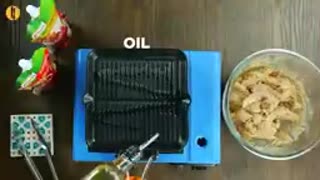Premium Only Content

Kitchenware - Storage _ Inventory
Proper **storage and inventory management of kitchenware** ensures efficiency, longevity of tools, and a smooth workflow in the kitchen. Here's a comprehensive guide to managing kitchenware effectively:
---
### **1. Storage of Kitchenware**
#### **A. Cookware (Pots, Pans, Baking Sheets)**
- **Organization:**
- Stack by size and type to save space and make items easy to retrieve.
- Use pot racks, wall-mounted hooks, or dedicated shelves for easy access.
- **Protection:**
- Place liners or soft mats between stacked items to prevent scratching.
- Hang frequently used pans to keep them easily accessible and in good condition.
#### **B. Knives**
- **Safe Storage:**
- Use knife blocks, magnetic strips, or in-drawer organizers to keep blades secure.
- **Hygiene:**
- Ensure knives are clean and dry before storage to prevent rust or bacteria growth.
- **Safety:**
- Always store blades facing downward or secured to avoid accidental cuts.
#### **C. Utensils**
- **Categorization:**
- Group utensils by function (e.g., mixing spoons, spatulas, tongs) and store in separate containers or drawer dividers.
- **Accessibility:**
- Keep frequently used utensils in countertop holders near prep areas.
#### **D. Small Appliances**
- **Designated Areas:**
- Store appliances like blenders, mixers, and food processors in cabinets or shelves close to their primary usage area.
- **Cord Management:**
- Wrap cords neatly to avoid tangling and damage.
- **Cleaning Before Storage:**
- Ensure appliances are thoroughly cleaned and dried to prevent mold or odors.
#### **E. Cutting Boards**
- **Vertical Storage:**
- Use a rack or slots to store cutting boards upright for proper air circulation.
- **Separation by Use:**
- Keep separate boards for raw meats, vegetables, and cooked foods to prevent cross-contamination.
#### **F. Specialty Tools**
- **Labeling and Grouping:**
- Store infrequently used tools (e.g., mandolines, pasta makers) in labeled bins or containers.
- Group similar tools together for easy retrieval.
---
### **2. Inventory Management**
#### **A. Inventory Tracking**
- **Maintain a Master List:**
- Create a detailed list of all kitchenware items, including quantities and condition.
- **Frequent Audits:**
- Conduct regular inventory checks (weekly or monthly) to ensure nothing is missing or damaged.
#### **B. Stock Levels**
- **Set Par Levels:**
- Determine minimum and maximum stock levels for essential items based on usage.
- **Replacements:**
- Track wear and tear and replace items proactively to avoid disruptions.
#### **C. Damage and Loss Monitoring**
- **Breakage Log:**
- Record damaged or lost items to identify trends and improve handling practices.
- **Staff Accountability:**
- Assign specific responsibilities for monitoring and reporting.
---
### **3. Maintenance and Cleaning**
#### **A. Regular Cleaning**
- Clean kitchenware immediately after use to prevent buildup and staining.
- Use appropriate cleaning tools (e.g., non-abrasive sponges for non-stick surfaces).
#### **B. Deep Cleaning**
- Schedule regular deep cleaning for items like cast iron pans, grills, or immersion blenders.
- De-lime or descale equipment like kettles and espresso machines to maintain performance.
#### **C. Inspections**
- Periodically inspect kitchenware for signs of damage, rust, or wear.
- Replace worn-out or unsafe items (e.g., knives with loose handles).
---
### **4. Storage Optimization**
#### **A. Vertical and Wall Space**
- Use wall-mounted racks, magnetic strips, or pegboards to maximize vertical storage.
- Hang heavy cookware and tools for easy access.
#### **B. Modular Storage**
- Use stackable bins, clear containers, or labeled baskets to group items efficiently.
- Store seasonal or rarely used items in higher cabinets or storage areas.
#### **C. Temperature and Humidity**
- Store sensitive items (e.g., knives, wooden utensils) in dry areas to prevent rust or warping.
---
### **5. Technology Integration**
- **Inventory Software:**
- Use digital tools to track kitchenware stock levels and conditions.
- **Barcoding or QR Codes:**
- Assign codes to frequently used items for efficient tracking and reordering.
---
### **6. Staff Training**
- Train staff on proper handling, cleaning, and storage procedures.
- Create visual guides or labels to ensure kitchenware is returned to the correct storage location.
Would you like help creating a kitchenware inventory template or advice on organizing a specific type of item?
-
 1:35
1:35
HSESafetyInformation
1 month agoMutton Chops two ways- baked & grilled Recipe by Food Fusion (Eid Recipe)
59 -
 55:12
55:12
Esports Awards
15 hours agoBarney Banks on Esports, TikTok Fame, Dancing & More | Origins Podcast #1
26.8K1 -
 6:38
6:38
Mrgunsngear
14 hours ago $7.91 earnedTrump's ATF Removes Zero Tolerance Policy For FFLs & More 🇺🇸
36.9K24 -
 22:07
22:07
JasminLaine
15 hours agoWatch CBC Realize They Can’t Save Carney—Poilievre Calls Him a “Political Grifter”
39.7K28 -
 58:51
58:51
Motherland Casino
9 hours agoPaula x Barbara
24.2K2 -
 4:27:58
4:27:58
Delnorin Games
7 hours ago🔴 Live - Call of Duty
14.4K1 -
 13:19
13:19
Bearing
1 day agoAustralian Prime Minister FALLS OFF STAGE Then Denies it Happened 🤣😂
27.3K53 -
 2:44:48
2:44:48
Price of Reason
16 hours agoTrump Tariff Mania CONTINUES! China vs Hollywood! Bezos Under FIRE! Sweet Baby Inc FAILS Again!
45.5K4 -
 2:39:40
2:39:40
TimcastIRL
13 hours agoTrump To Impose 104% TARIFF On China At Midnight In NUCLEAR BOMB On Global Trade | Timcast IRL
286K150 -
 1:54:27
1:54:27
Glenn Greenwald
15 hours agoAs Tariffs Dominate News, Trump and Netanyahu Make Increasingly Militaristic Threats; Plus: Mixed Supreme Court Ruling on Deportation Powers | SYSTEM UPDATE #435
180K209